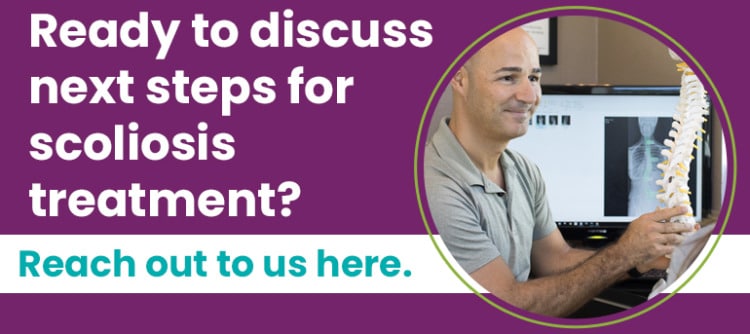Who Is Most Affected by Scoliosis? Who Suffers Most?
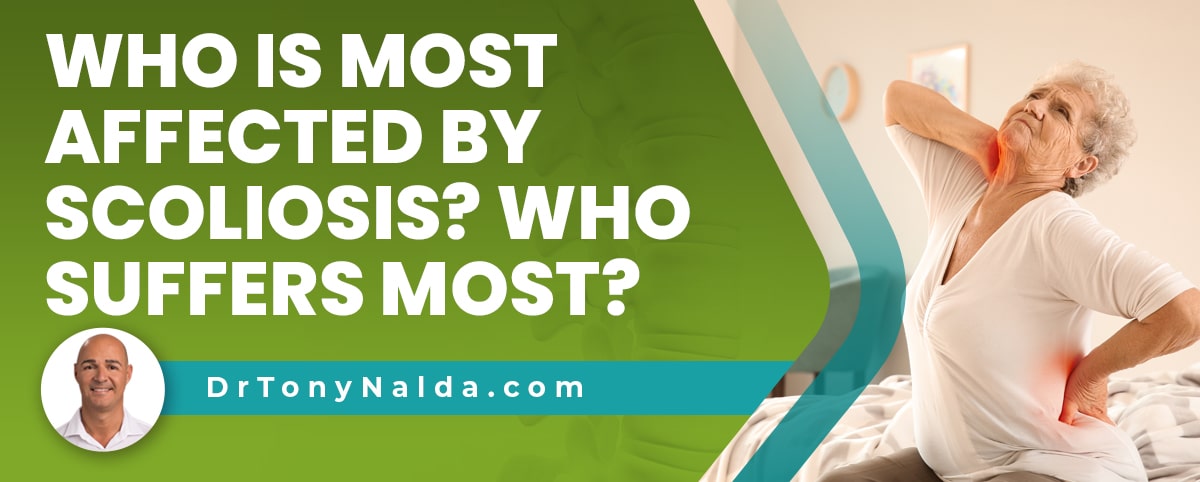
When it comes to who is most affected by scoliosis in the context of prevalence, that would be adolescents diagnosed with adolescent idiopathic scoliosis (AIS). Determining who suffers the most in terms of pain and severe symptoms involves a number of factors.
The most common type of scoliosis is adolescent idiopathic scoliosis, so adolescents are the age group most commonly affected; when it comes to suffering from back pain and severe symptoms, this would include adults for whom scoliosis is compressive, atypical condition types, and/or cases of untreated scoliosis.
While scoliosis affects all ages, adolescent scoliosis is the most common type of scoliosis.
Table of Contents
Adolescent Idiopathic Scoliosis
Scoliosis affects all ages, and it is the leading spinal condition among school-aged children.
Babies can be born with congenital scoliosis, infants diagnosed with infantile idiopathic scoliosis between the ages of 6 months and 3 years, early onset juvenile scoliosis diagnosed in children between the ages of 3 and 10, and adolescent idiopathic scoliosis is diagnosed between the ages of 10 and reaching skeletal maturity.
Adult scoliosis is diagnosed once growth has stopped and skeletal maturity has been reached, and in the aging population, the rate of scoliosis increases: due to age-related spinal degeneration.
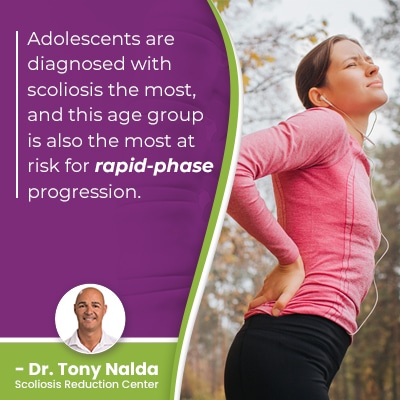 Adolescents are diagnosed with scoliosis the most, and this age group is also the most at risk for rapid-phase progression.
Adolescents are diagnosed with scoliosis the most, and this age group is also the most at risk for rapid-phase progression.
While we don't know what triggers the condition's initial onset, we know it's growth that makes it progress, and progression means the size and rotation of the unnatural spinal curve is getting worse, condition effects are increasing, and conditions are becoming more complex to treat.
Because of the rapid and unpredictable growth spurts of puberty, these cases of scoliosis can progress quickly, and this is why being proactive with treatment is so important.
So in the context of prevalence, it's adolescents who suffer the most with scoliosis because they are the most commonly diagnosed, and they are also the most at risk for rapid progression due to the stage of growth these patients are in.
But what about the severity of symptoms? Surely, the more painful a condition is, the more a patient will potentially suffer.
Suffering with Scoliosis Pain
No two cases of scoliosis are the same, which is why the condition's nature necessitates the complete customization of treatment plans.
What one patient experiences doesn't necessarily indicate what others will face, particularly when it comes to scoliosis pain.
For children, scoliosis isn't commonly experienced as painful, and this is because scoliosis doesn't become a compressive condition until growth has stopped.
For children, the main symptoms of scoliosis involve postural changes (uneven shoulders, uneven shoulder blades, uneven hips, development of a rib cage arch), and the lack of compressive pain is a barrier to early detection and intervention, but in adults, pain is the main symptom that leads to a diagnosis and treatment.
In young patients whose spines are still growing, the constant lengthening motion of growth counteracts the compressive force of the unnatural spinal curve, but once growth stops, it's compression of the spine and its surrounding muscles and nerves that is the main cause of condition-related pain.
So adults are more likely to suffer from scoliosis pain than children, but there is also condition severity and type to consider, and atypical condition types can be particularly severe.
Condition Severity
One of the main factors that treatment plans need to be shaped around is condition severity because scoliosis ranges widely in severity from mild scoliosis to moderate scoliosis, severe and very severe scoliosis.
Condition severity is determined during X-ray based on a measurement known as Cobb angle that determines how unnaturally tilted the spine's vertebrae are, and the higher a patient's Cobb angle, the more severe the condition.
The more severe a condition is, the larger the size of the unnatural curve is, and/or the more it has progressed, and the more overt its symptoms are likely to be, including postural changes and pain.
The more severe a condition becomes, the more suffering there is likely to be as condition effects become more overt and noticeable.
In some cases, condition type also shapes severity because type is determined by causation, and some types are considered atypical because they are so severe and have unique treatment needs.
Atypical Scoliosis Types
The most common type of scoliosis overall is idiopathic scoliosis, accounting for approximately 80 percent of known cases, and the remaining 20 percent are associated with known causes and are considered atypical: neuromuscular scoliosis, degenerative scoliosis, and congenital scoliosis.
In typical cases of idiopathic scoliosis, curves bend to the right, away from the heart, but in atypical cases of scoliosis, curves can bend to the left, towards the heart, and this is problematic and is a red flag that there is an underlying pathology causing the scoliosis to develop.
Among the different condition types I've treated over the years, my neuromuscular scoliosis patients are among the most severe and complex to treat; the scoliosis develops as a secondary complication of a larger neuromuscular condition.
These patients tend to develop severe scoliosis, with some becoming wheelchair bound and unable to walk on their own.
Cases of congenital scoliosis are caused by spinal malformations that occur in utero, and these cases often present with additional congenital abnormalities so need to be comprehensively assessed.
Degenerative scoliosis affects older adults, most often over the age of 45, and is caused by natural age-related spinal degeneration, and as this condition type can be particularly painful as the spine becomes increasingly unbalanced and unstable.
Untreated Scoliosis
People most affected by scoliosis include those who develop related complications as a result of leaving their condition untreated.
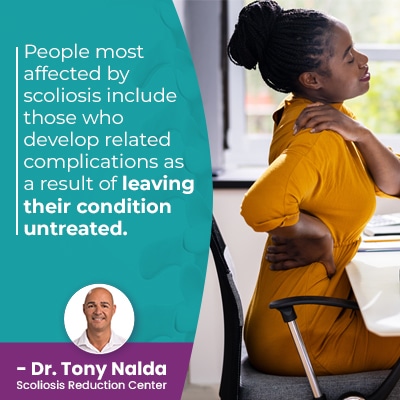 While there are no treatment guarantees, scoliosis can be highly treatable, particularly with early diagnosis and treatment, but when scoliosis is left untreated, it can progress unimpeded, becoming very severe and causing related complications.
While there are no treatment guarantees, scoliosis can be highly treatable, particularly with early diagnosis and treatment, but when scoliosis is left untreated, it can progress unimpeded, becoming very severe and causing related complications.
Suffering from scoliosis can mean experiencing the consequences of leaving a progressive condition untreated, and when very severe, complications of untreated scoliosis can include difficulty breathing, cardiac issues, digestive issues, and chronic back pain.
So while some factors are uncontrollable, when it comes to minimizing the condition's potential effects and complications, the best approach is proactive treatment that addresses the condition's underlying structural nature.
The best way to stop patients suffering from condition affects is to minimize those affects as much as possible by treating conditions proactively; this means starting treatment as close to the time of diagnosis as possible with the goal of working towards preventing progression, increasing effects, and the need for invasive surgical treatment in the future.
The reality is that many cases of scoliosis don't need surgical treatment, but only patients who have committed to a non-surgical conservative treatment approach will benefit from what early detection and intervention have to offer; traditional treatment doesn't have a strategy for addressing scoliosis while mild, which happens to be when it's the simplest to treat and is likely to be the most responsive.
So as a progressive condition whose nature is to get worse over time, those who are likely to suffer the most are those whose conditions are undiagnosed and untreated and become very severe and develop related complications, that in many cases, could have been avoidable if addressed early on.
Conclusion
As a progressive condition, scoliosis treatment is about managing an ongoing condition.
The most common type of scoliosis people are diagnosed with is called idiopathic scoliosis, and the age group most at risk of suffering from continued and rapid progression are adolescents diagnosed with adolescent idiopathic scoliosis.
When it comes to scoliosis pain, this most often affects adults and patients with particularly severe and/or atypical types of scoliosis like neuromuscular scoliosis that's caused by the presence of a larger neuromuscular condition like cerebral palsy, muscular dystrophy, or spina bifida.
Untreated scoliosis can also cause severe symptoms and potential complications, but scoliosis treated proactively can mean minimizing the potential effects of scoliosis.
Scoliosis treatment needs to address the condition on multiple levels, which is why an integrative approach that can be easily adjusted and customized can be so effective.
Spinal fusion surgery can result in a weaker spine that's less flexible, and in some cases, there can be increased pain at the fusion site, and a spine that's weaker is more vulnerable to injury, but spinal deformities addressed with conservative treatment options can lead to a healthier and more functional spine in the future.
Proactive treatment is the most likely to prevent scoliosis from getting worse and causing increasing symptoms, and it can help spare patients the potential hardships associated with invasive spinal surgery.
An unnatural curvature of the spine always needs treatment, especially when they are progressive.
Dr. Tony Nalda
DOCTOR OF CHIROPRACTIC
After receiving an undergraduate degree in psychology and his Doctorate of Chiropractic from Life University, Dr. Nalda settled in Celebration, Florida and proceeded to build one of Central Florida’s most successful chiropractic clinics.
His experience with patients suffering from scoliosis, and the confusion and frustration they faced, led him to seek a specialty in scoliosis care. In 2006 he completed his Intensive Care Certification from CLEAR Institute, a leading scoliosis educational and certification center.
About Dr. Tony Nalda
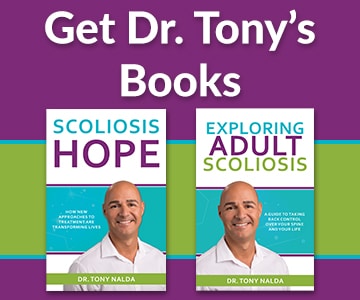 Ready to explore scoliosis treatment? Contact Us Now
Ready to explore scoliosis treatment? Contact Us Now